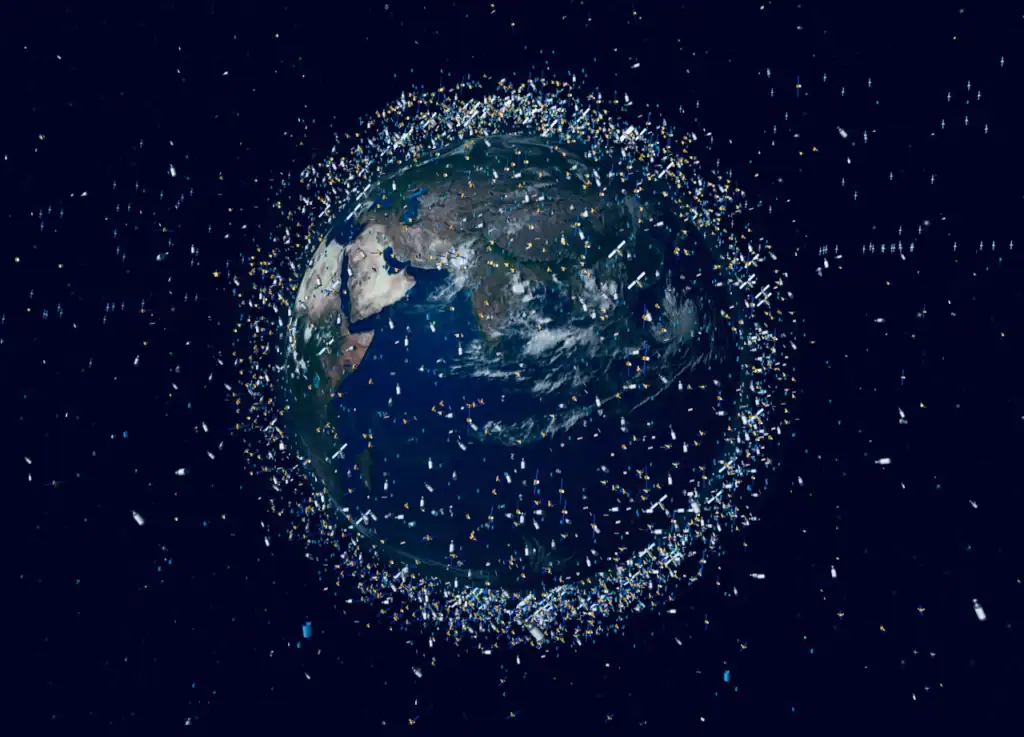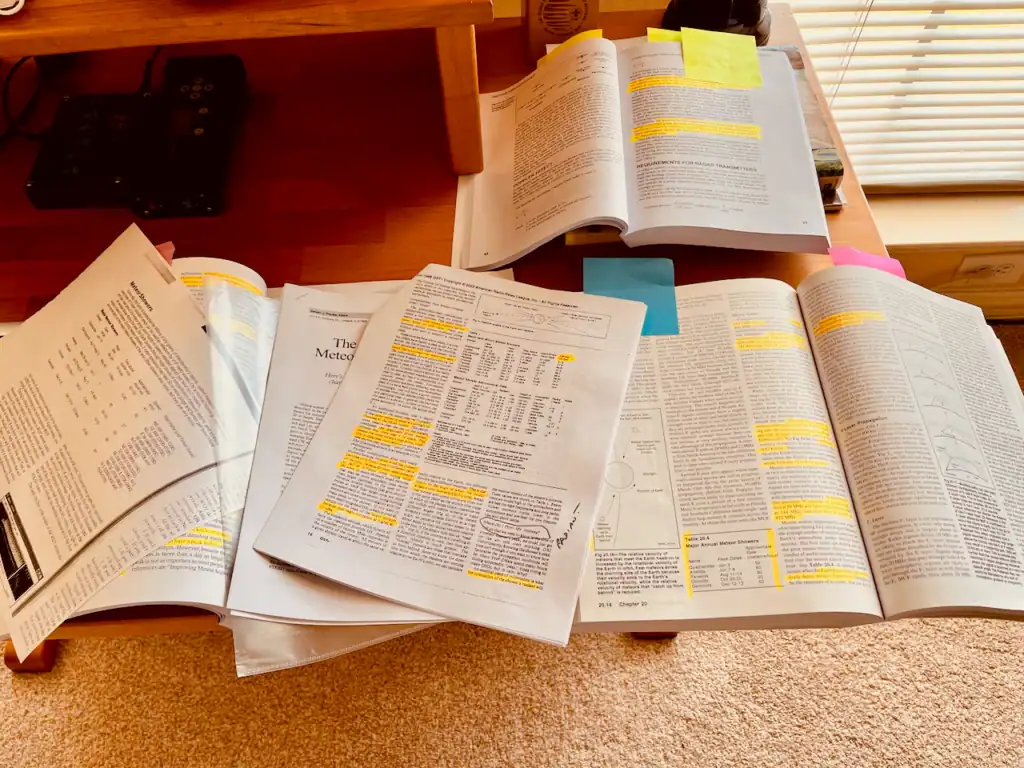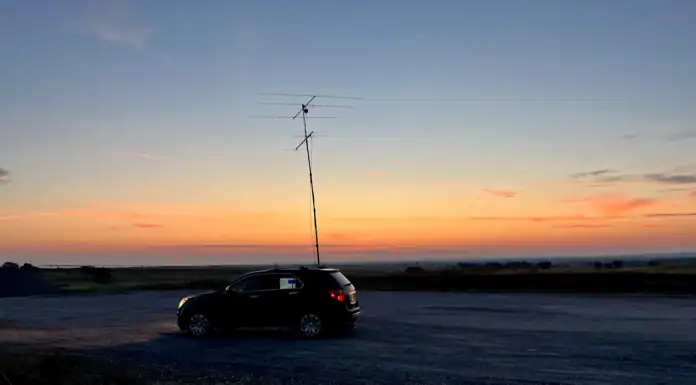What are the 6 Key Factors?
My reflections on this topic revealed six factors I believe are at play. The first three explore the mechanisms behind normal, if that term applies, meteor scatter QSOs. The remaining three examine space debris characteristics and how they compare with meteor scatter contacts. This, in turn, reveals whether space debris or junk could result in meteor scatter QSOs.
1. E-Layer Ionization
In a typical meteor scatter contact, the transmitted radio signal is bounced off an ionized patch of the E-layer. That patch is ionized by the meteor’s path through the E-layer. I like this summary from the ARRL Handbook.
The kinetic energy of meteors no larger than grains of rice is sufficient to ionize a column of air 20 km (12 miles) long in the E layer. The particle itself evaporates … but the ionized column may persist for a few seconds or a minute or more before it dissipates.
2. E-Layer Height
That mechanism spells out two primary principles of meteor scatter QSOs. The first is that everything happens in the E-layer. The second is that the radio signal’s reflections are from an ionized patch in the E-layer, not from the meteor itself.
With those principles in mind, the height of the E-layer becomes a critical element as well as the height of the meteor scatter ionization paths. The height of the E-layer is 90 to 150 km. The height of meteor ionization varies from 95 km for the Geminids shower to 115 km for Eta Aquarids and 150 km for the Leonids. The remaining showers are in the 100 km range.
3. Meteor Velocity
Another factor that affects this is the speed of the meteor as it enters the E-layer — the faster it travels, the more ionization occurs. This is the main reason why meteor scatter QSOs are much more common in the early morning hours than in the evening. In the morning, the Earth moves into the meteor path, and the Earth’s rotation helps increase the overall velocity. The opposite happens in the evening.
Meteor velocity runs from a low of 28 to 30 km/sec for the Taurids to a high of 70 km/sec for the Leonids. The Perseids come in at 59 km/sec, Quadrantids at 41 km/s, and Geminids at 34 km/sec.
So that provides the overall baseline for our typical meteor scatter contacts. Comparing that information to the same data for space debris should provide sufficient insight into the likelihood of space junk helping our meteor scatter contacts.

4. Space Debris Height
NASA has provided some summary data on space debris. The key figures are 6,000 tons of material in Low Earth Orbit (LEO). LEO is considered to be orbits below 2,000 km, which is where our amateur radio satellites operate. As another reference point, Starlink satellites operate between 340 and 550 km. In contrast, geostationary orbits are at 35,786 km and must be precisely above the equator. A quick search shows that the lowest possible orbit for space debris is 160 kilometers. That rare orbit is still above the E-layer and, therefore, is not expected to generate ionization.
5. Space Debris Velocity
NASA reports that space debris can reach speeds of 18,000 miles per hour, which is roughly 29,000 km/h or 8 km/sec. This velocity is much lower than the meteors mentioned earlier, which start at 28 km/sec and can go up to 70 km/sec. Therefore, it doesn’t seem that space debris could generate any E-layer ionization, either from its height or its velocity.
Space debris burning up on reentry could cause some ionization. That burnout occurs at 75 to 110 km, so it is within the E-layer, but any ionization would depend on its velocity, not just the fire. Plus, it would be a single, very rare event on the path between two stations.
6. Space Debris Direct Reflection
Okay, so E-layer activation is ruled out, but there’s another possibility: direct reflection from space debris. This hypothesis has two main issues: the surface area and how it is oriented toward the transmitting and receiving stations.
Space debris consists of miscellaneous chunks of satellites that have broken apart or been shredded by the same meteors we’re tracking. Even if the satellite remains intact, it wouldn’t be a typical reflector. In fact, all space debris is likely rotating at some speed. Moreover, I don’t believe that any space junk reaches the size of the ionized trail noted above, 12 km or 20 miles long.
Further Thoughts — Doppler Effect
The RSGB Amateur Radio Astronomy book provides some interesting figures to add to this mix. They note that if RF signals were reflected directly from the meteors themselves, the Doppler effect at 144 MHz would range between 14 and 67 kHz. Of course, we’re receiving signals from the relatively stable ionized E-layer with minimal Doppler.
That same Doppler effect would also apply to space debris, although moving at a lower velocity. A further data point is that the Doppler Effect on 144 MHz for LEO amateur radio satellites is +/- 3kHz. Those with a more calculating mind than mine can generate similar numbers for space debris or other bands.
Mike, WB2FKO, has written a great deal on the topic of meteor scatter. See his paper “Doppler shift on meteor scatter pings” in the Central States VHF Society 2022 Conference Proceedings. You can also find further information at WB2FKO Technical Notes.
Final Thoughts
Given all this, while “no way” might be too strong, I believe it’s doubtful that space debris or junk could reflect our RF signals toward the receiving station. Please feel free to leave your comments below.
If you want to try it out, read Meteor Scatter: Getting on the Air — How it Works.
Further Reading:
ARRL Handbook, Chapter 20: Propagation, Meteor Scatter
QST June 1986 VHF Meteor Scatter — An Astronomical Perspective
ARRL Operating Manual, VHF/UHF Beyond Repeaters, Meteor Scatter
RSGB Amateur Radio Astronomy







